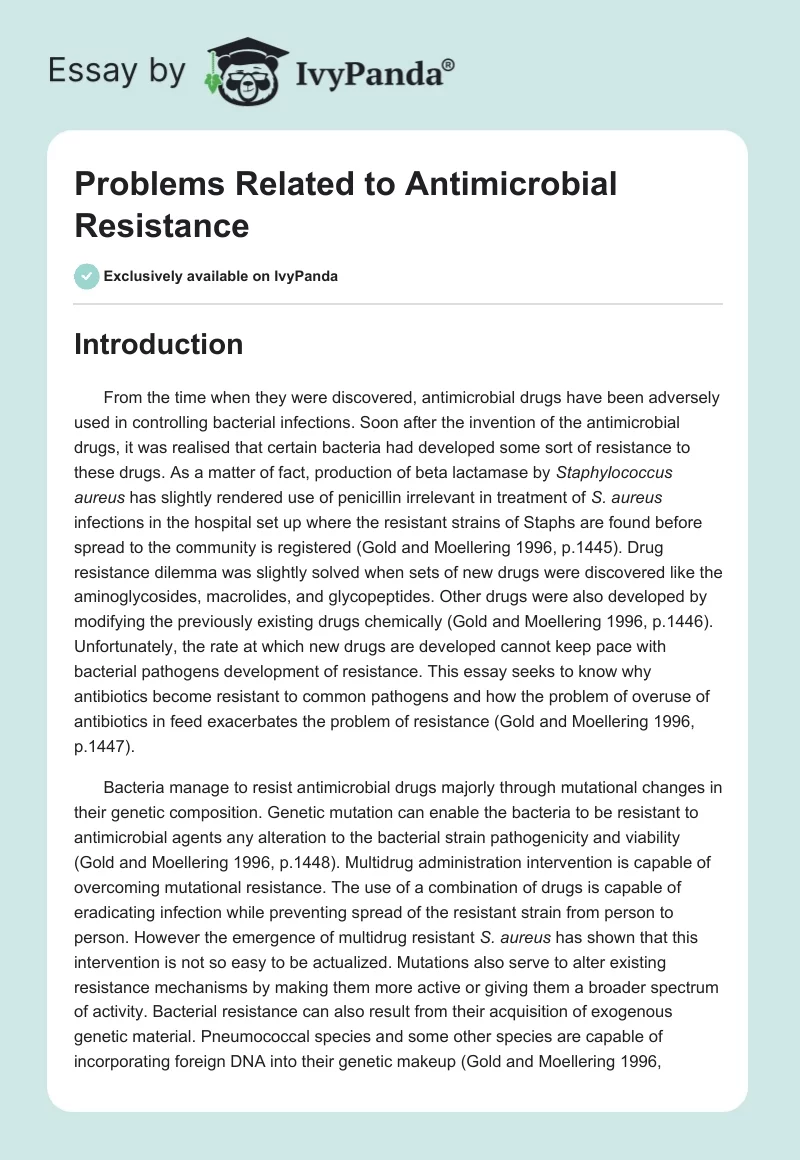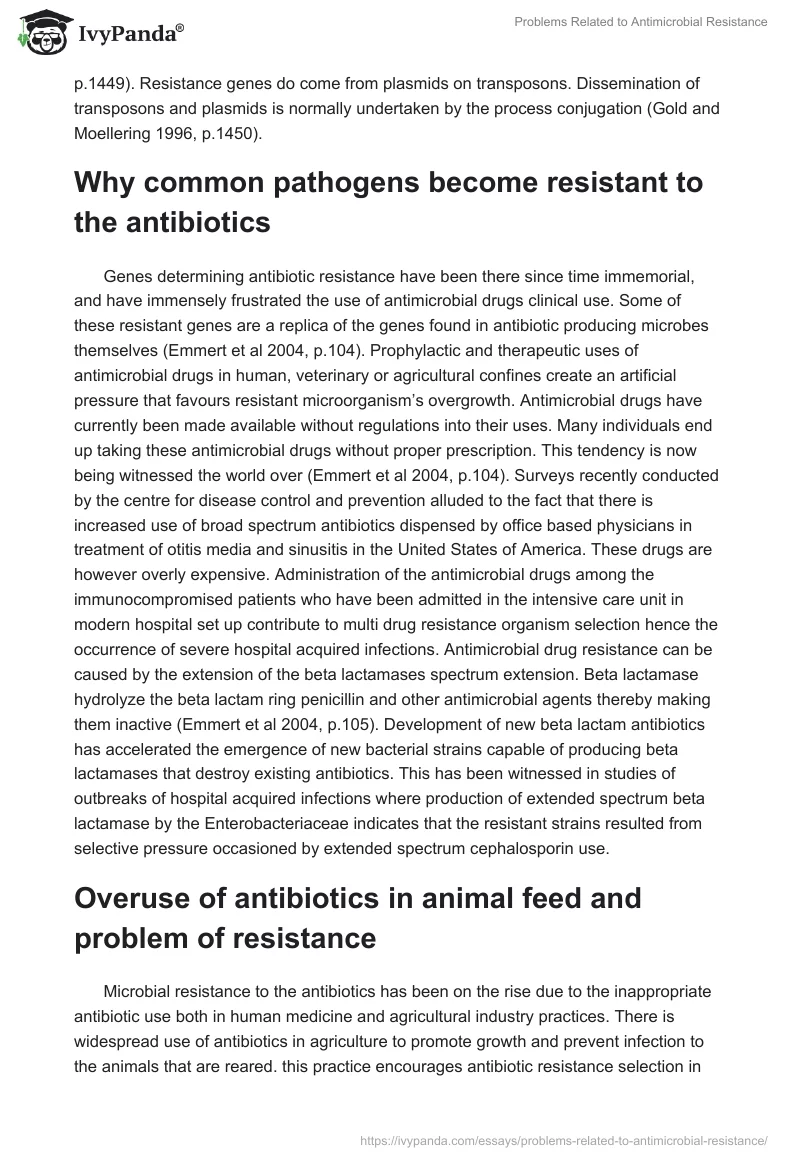Introduction
From the time when they were discovered, antimicrobial drugs have been adversely used in controlling bacterial infections. Soon after the invention of the antimicrobial drugs, it was realised that certain bacteria had developed some sort of resistance to these drugs. As a matter of fact, production of beta lactamase by Staphylococcus aureus has slightly rendered use of penicillin irrelevant in treatment of S. aureus infections in the hospital set up where the resistant strains of Staphs are found before spread to the community is registered (Gold and Moellering 1996, p.1445). Drug resistance dilemma was slightly solved when sets of new drugs were discovered like the aminoglycosides, macrolides, and glycopeptides. Other drugs were also developed by modifying the previously existing drugs chemically (Gold and Moellering 1996, p.1446). Unfortunately, the rate at which new drugs are developed cannot keep pace with bacterial pathogens development of resistance. This essay seeks to know why antibiotics become resistant to common pathogens and how the problem of overuse of antibiotics in feed exacerbates the problem of resistance (Gold and Moellering 1996, p.1447).
Bacteria manage to resist antimicrobial drugs majorly through mutational changes in their genetic composition. Genetic mutation can enable the bacteria to be resistant to antimicrobial agents any alteration to the bacterial strain pathogenicity and viability (Gold and Moellering 1996, p.1448). Multidrug administration intervention is capable of overcoming mutational resistance. The use of a combination of drugs is capable of eradicating infection while preventing spread of the resistant strain from person to person. However the emergence of multidrug resistant S. aureus has shown that this intervention is not so easy to be actualized. Mutations also serve to alter existing resistance mechanisms by making them more active or giving them a broader spectrum of activity. Bacterial resistance can also result from their acquisition of exogenous genetic material. Pneumococcal species and some other species are capable of incorporating foreign DNA into their genetic makeup (Gold and Moellering 1996, p.1449). Resistance genes do come from plasmids on transposons. Dissemination of transposons and plasmids is normally undertaken by the process conjugation (Gold and Moellering 1996, p.1450).
Why common pathogens become resistant to the antibiotics
Genes determining antibiotic resistance have been there since time immemorial, and have immensely frustrated the use of antimicrobial drugs clinical use. Some of these resistant genes are a replica of the genes found in antibiotic producing microbes themselves (Emmert et al 2004, p.104). Prophylactic and therapeutic uses of antimicrobial drugs in human, veterinary or agricultural confines create an artificial pressure that favours resistant microorganism’s overgrowth. Antimicrobial drugs have currently been made available without regulations into their uses. Many individuals end up taking these antimicrobial drugs without proper prescription. This tendency is now being witnessed the world over (Emmert et al 2004, p.104). Surveys recently conducted by the centre for disease control and prevention alluded to the fact that there is increased use of broad spectrum antibiotics dispensed by office based physicians in treatment of otitis media and sinusitis in the United States of America. These drugs are however overly expensive. Administration of the antimicrobial drugs among the immunocompromised patients who have been admitted in the intensive care unit in modern hospital set up contribute to multi drug resistance organism selection hence the occurrence of severe hospital acquired infections. Antimicrobial drug resistance can be caused by the extension of the beta lactamases spectrum extension. Beta lactamase hydrolyze the beta lactam ring penicillin and other antimicrobial agents thereby making them inactive (Emmert et al 2004, p.105). Development of new beta lactam antibiotics has accelerated the emergence of new bacterial strains capable of producing beta lactamases that destroy existing antibiotics. This has been witnessed in studies of outbreaks of hospital acquired infections where production of extended spectrum beta lactamase by the Enterobacteriaceae indicates that the resistant strains resulted from selective pressure occasioned by extended spectrum cephalosporin use.
Overuse of antibiotics in animal feed and problem of resistance
Microbial resistance to the antibiotics has been on the rise due to the inappropriate antibiotic use both in human medicine and agricultural industry practices. There is widespread use of antibiotics in agriculture to promote growth and prevent infection to the animals that are reared. this practice encourages antibiotic resistance selection in bacterial populations Khachatourians 1998, p.1131). The resistant bacteria from the animals may be transferred to the human beings when they eat animal products. A disease that cannot be treated using conventional antibiotics may result. Improvement of the growth of swine is normally enhanced by the use of bacitracin and other antimicrobial agents that are added to the animal feed Khachatourians 1998, p.1131). Administration of such antibiotics even in low quantities can result in selection of antibiotic resistant bacteria. However, these feeds normally contain more than the recommended quantities. Farmers who undertake commercial farming are more likely to use large quantities of antimicrobial agents in their farms (Khachatourians 1998, p.1131). Resistance may be passed on from animals to the animal faeces or sewage then to the water surface of water, irrigation of vegetable crops and eventually into humans who may pass the resistance to the community around or to the hospitals (Khachatourians 1998, p.1130).
Conclusion
Mitigation of problems related to antimicrobial resistance solely lies with individuals because it is them who can guard against over the counter purchase of these antibiotics and their over or under dosage which has been implicated in development of resistance. Farmers should also avoid giving too much antibiotics to their animals.
Reference List
Emmert, E. A. B., Klimowicz, A. K., Thomas, M. G., Handelsman, J. (2004). Genetics of Zwittermicin A Production by Bacillus cereus. Appl. Environ. Microbiol. 70: 104-113
Gold, H.S. and Moellering, R.C. (1996).Antimicrobial drug resistance. New England Journal of Medicine, 335, 1445-1453.
Khachatourians, G.G. (1998). Agricultural use of antibiotics and the evolution and transfer of antibiotic-resistant bacteria. Canadian Medical Association Journal, 159(9), 1129-1136.


